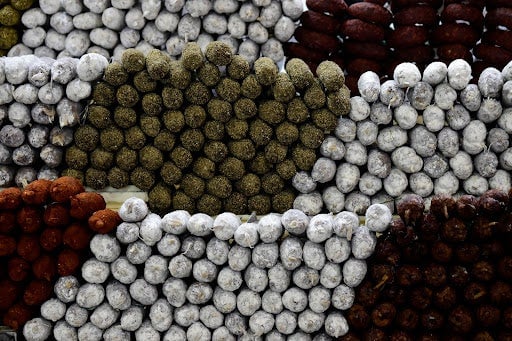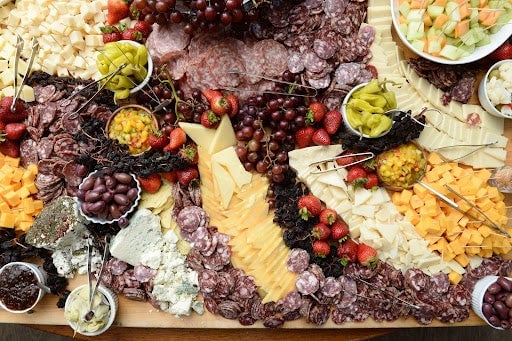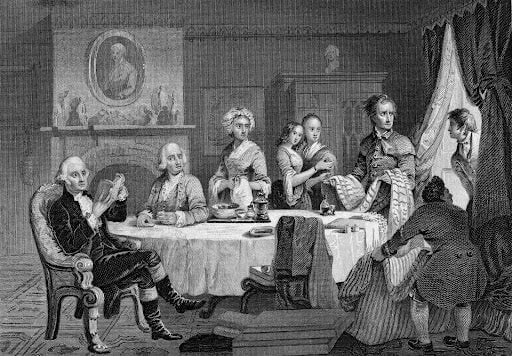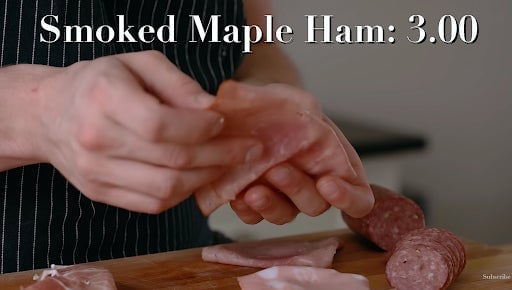Charcuterie: Global board meeting
Cured to perfection

Cured to perfection
Suggested Reading
Is there anything more democratizing than a charcuterie board? Every cracker, cheese, and nut is on even footing (unless you’re into making an entire leg of jamón your centerpiece), grazers get to pick which morsels they want on their plate, and tabletops at casual hangs or elevated affairs welcome the platters easily.
Related Content
The modern charcuterie board now features an often photogenic-on-purpose array of co-stars like cheeses, nuts, olives, and other edibles. How did the process of meat curing, first documented around 40,000 BC in Sicily, turn into Instagram accounts dedicated to salami rose folding? And why did a dish that’s meant to be shared with others become so popular during a pandemic that forced us to isolate ourselves?
Grab your plate, it’s time to layer some facts.
By the digits
21: Days it took to cure meat before chemist Ed Polenske discovered how nitrite really works (though certain meats are still traditionally cured for longer periods of time)
6.25%: Sodium nitrite concentration of Prague Powder #1, the most popular curing salt that’s blush pink in color
$585.5 billion: Size of the global processed meat market as of this year
25 million: Pigs butchered in France every year, though that number is declining
3 oz (85 g): Optimal serving size per person of cured meat on a charcuterie board, if served as an appetizer. It’s also recommended to add cheese as an accompaniment (consider this your permission to use more).
34,000: Cancer-related deaths each year linked to processed meats
150.05 ft (45.73 m): Length of the world’s longest charcuterie board
76.5 million: Views of content tagged with #charcuterie on TikTok
$600 per kg: Price of pule, the world’s most expensive cheese, made from the milk of donkeys at a single farm in Serbia
2 minutes: Time it takes to craft a salami rose
1 metric ton: Volume of CO2 emissions the average American would save annually if they were vegetarian

The charcuterie influence
While charcuterie traditionally refers only to cured meats, today’s charcuterie board might not even have any meat on it. Typical pairings like cheeses, nuts, and fruits, are playing larger roles on the wooden stage, and charcuterie has grown to become a catch-all phrase for themed snack boards and butter monstrosities, encouraging a big eye roll from the food elites.
But hey, we’re not too beholden to definitions around here, and neither were our earliest meat-curing ancestors. Their top concern wasn’t TikTok notoriety, but having nonperishable food during times of scarcity. Since the medieval period, laborers in Europe have been packing simple combinations of meats, breads, and cheeses for lunch long before these items became a delicacy at formal dinners across France, Great Britain, and America in the 18th and 19th centuries.
But in the age of social media and an isolation-inducing pandemic, charcuterie boards boomed into something much bigger than “adult Lunchables.” Their low-stakes approachability (anyone can open a bag) made plating an art form for even the most culinarily inept and chronically bored. And surely the DIY aspect of going to the grocery store, purchasing what you want, and arranging it in whatever fashion you see fit, helped establish a sense of control over something during the height of pandemic lockdowns.
Charcuterie boards have also proven to be big money for influencers who hopped on the trend early and amassed tens of thousands of followers (and book deals) for their content.
Charcuterie around the world
Do you know your global charcuterie?
🌭 Liverwurst, or liver fermented sausage, and mettwurst, or pork sausage, are common processed meats to put on any German-inspired board.
🍖 Jamón, or dried Spanish ham, and chorizo, the chopped or ground meat sausage, are cured favorites in Spain.
🐽 Jinhua ham is cured ham from China’s Zhejiang Province that’s banned from export to the US.
🐄 Biltong is a cured and dried meat, mostly made from beef, from South Africa.
Quotable
“Like a beautiful church, a cheese plate is about more than aesthetics; it’s the altar at which we gather to worship our Lord Cheesus. It sparks conversation, smoothes awkward moments between strangers at parties, and it even buys you time if dinner runs late.”
—Cheesemonger Erika Kubick explaining the art of plating a snackboard in her book Cheese Sex Death: A Bible for the Cheese Obsessed

Pop quiz
What bevy did first US president George Washington pair with his nightly walnuts?
A: Three glasses of madeira
B: A cup of coffee from Mocha, Yemen
C: Perfectly steeped Hyson tea
D: A swig of rye whiskey from his own distillery
Find the correct answer at the bottom!
Brief history
40,000 BC: Evidence of meat curing is painted on caves in Sicily.
Fun fact!
Scientists still don’t really know a whole lot about the hard crystals that form in cheeses as they age. Two of the most common ones are tyrosine (the crunchy ones) and calcium lactate (the softer ones that look like mold but are harmless). Cheese crystals, once considered a defect, are now having a renaissance.

Watch this!
A tale of two boards
When it comes to creating your own charcuterie board, you can’t really go wrong. But there’s no way around it: fancy cheese and meats come with higher price tags, especially in this era of record inflation. While you can splurge on this $65-a-pound banana leaf-wrapped blue cheese (which this author can confirm tastes like pineapples), it doesn’t have to be that way.
YouTube chef Joshua Weissman explains how to make two different boards, one that costs $30 and one that costs $130, and honestly, they both look great? Pro tip: buy some rosemary sprigs to fill in the vacant areas for some instant elevation.
Take me down this 🐰 hole!
Nixing the nitrite
Back in 2015, processed meat was in the hot seat after the World Health Organization classified it (pdf) as a group 1 carcinogen, the same level as cancer-causing substances like tobacco. It was shocking for most. As Wired so aptly put it, “Perhaps no two words together are more likely to set the internet aflame than BACON and CANCER.”
The culprit is carcinogenic N-nitroso compounds that come from two places in processed red meat: the breakdown of an iron-based chemical called heme, and the curing process itself, which uses nitrites and nitrates that eventually turn into N-nitroso compounds. In its announcement, the WHO said it had found enough evidence that eating meat containing these compounds was specifically linked to higher cancer risk, mostly colorectal.
Because of the group 1 carcinogen classification, a lot of people came to believe that eating processed meats had the same level of cancer risk as smoking cigarettes. That’s not exactly right, as the WHO’s International Agency for Cancer Research doesn’t assess the size of cancer risk. Case in point: smoking can increase someone’s risk of getting lung cancer by 2,500%, while eating two slices of bacon a day can increase the risk of getting bowel cancer by 18%.
But the difference in relative risk doesn’t mean the additives used to cure aren’t still being scrutinized. Just this year, France moved to cut nitrites in food after the country’s Agency for Food, Environmental and Occupational Health & Safety came out firmly against processed meat. Many had feared an outright ban would be coming, but—at least for the time being—charcuterie will live to adorn another platter in its birthplace.
Does your office lay out a nice charcuterie board every day?
Wouldn’t that be something? And if not a charcuterie board, then at least better lighting. Or great social spaces. Or maybe just peace and quiet.
Office architects are blowing up templates and experimenting with bold ideas to suit the way we’re working now.
🎧 Our new podcast, Work Reconsidered, tackles office design. Listen on: Apple Podcasts | Spotify | Google | Stitcher
💬 Let’s talk!
In last week’s poll about mockumentaries, 55% of you thought the Borat movies definitely do not count as mockumentaries, 29% thought we were overthinking it, but 15% agreed it was gray area.
Today’s email was written by Morgan Haefner (immediately went grocery shopping after writing this) and edited by Susan Howson (dutifully arranges each board around a meat river).
The correct answer to the quiz is A. Three glasses of madeira, although he did enjoy all of those drinks, just at different times.